What’s inside?
Guest post by Bjorn Vang Jensen, Vice President, Advisory Services – Global Supply Chain, Sea-Intelligence
One predictor of port congestion is the transit time changes, which measure the time it takes container vessels to move from one port to berth in the next. While this is obviously a retrospective indicator (refers to vessels that have already arrived), it is useful when discerning patterns relative to specific ports and is a reliable metric to identify building congestion.
Based on updated data from Windward’s Port Insights, which analyzes global port performance and trends, we see some interesting changes in movement from July up to mid-August. Looking only at these transit times – Hamburg and Ningbo stand out as ports that are seeing congestion.
This tallies very well with what is happening on the ground: Ningbo is dealing with the aftereffects of the Shanghai closure and it is also possible that some sourcing patterns have shifted at least semi-permanently as a result of that event. Hamburg, in turn, has suffered the effects of a crippling strike during this period and so the numbers here are also not surprising.
On that note – and while the Hamburg strike has now ended in an agreement between the striking workers and the employers – Felixstowe, which has performed very well, has now been hit by an equally tough strike. This may swiftly be followed by Liverpool, so it is highly likely that next month’s update will see those two ports in a very different situation.
The biggest stand-out, however, is the performance of U.S. West Coast ports. All three main ports – Los Angeles, Long Beach, and Oakland – are showing significant drops in congestion.
This can be explained by the facts that volumes from China are generally dropping (along with rates) and that volumes have shifted to East Coast ports for fear of getting caught up in a strike by the ILWU.
Secondly, the relative ease of getting a berth belies the fact that these ports are still suffering massive yard congestion, primarily caused by the inadequate rail availability, but also by multiple factors related to trucking.
This situation is not going to be resolved anytime soon, and if volumes return to the West Coast after a successful contract negotiation with the union, we could well see these ports once again being unable to handle the volumes.
A bittersweet note: if volumes continue their decline, then this would obviously ease congestion in and of itself. But they would have to decline a lot before the impact would filter through to the ports, and there would be a significant time lag.
The fact that many other ports globally also seem to be coping well is also possibly related to volume downfalls.
Going forward, the events and circumstances to watch out for are:
1. Continued and possibly expanding strike activity in Europe
2. Closure of European inland waterways to barge traffic due to drought, which will put pressure on trucking availability from main ports, and therefore almost certainly increase port/yard congestion
3. This will possibly be counteracted by a similar situation in China, which could see volumes drop as factories close voluntarily or under pressure, as river traffic is either halted or reduced
4. Outcome of negotiations with ILWU on the U.S. West Coast
5. Volume shifts back to the West Coast as congestion increases in U.S. East Coast ports
6. Transition from peak season to slack season, which usually kicks in at the end of September, prior to China’s Golden Week celebration in early October. This could generate a small spike in volumes in September, as cargo owners prepare for China being effectively closed, but with volumes already down, this is unlikely to have a major effect
Shippers are currently enjoying a downturn in spot rates and many contracts are also being reviewed and amended. But the tangled global supply web is not in any way in better shape than it has been for the past two years.






